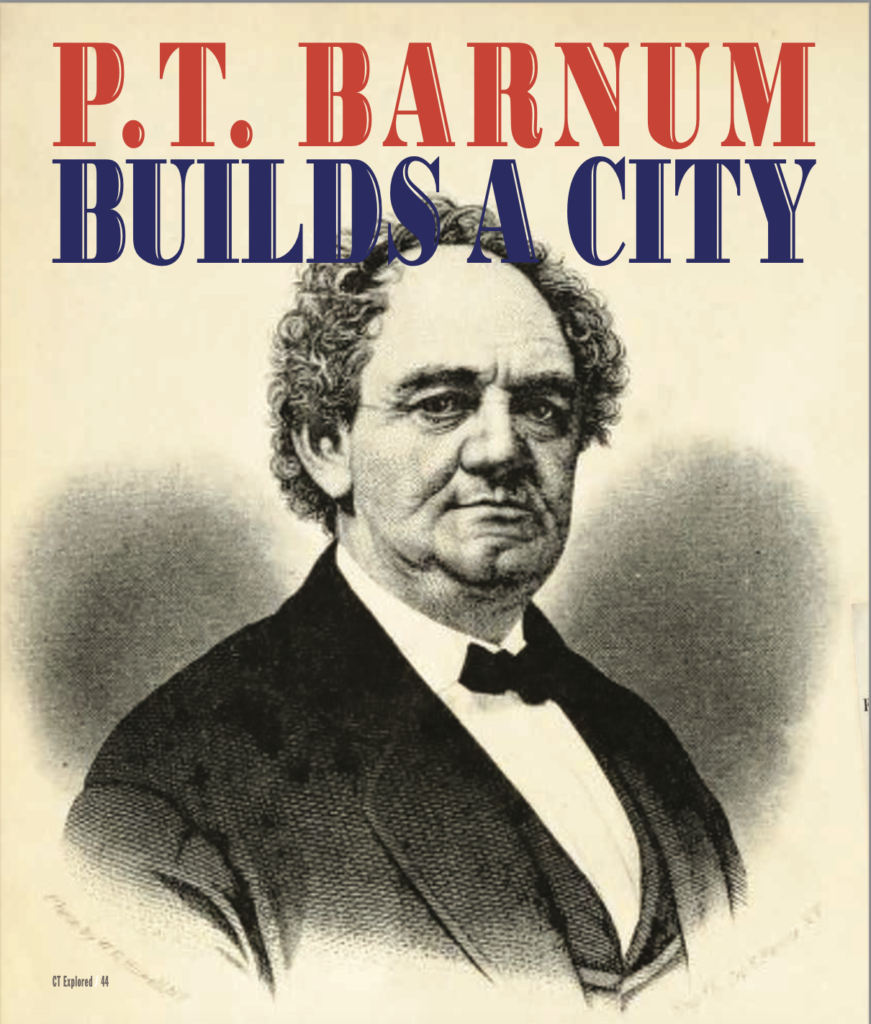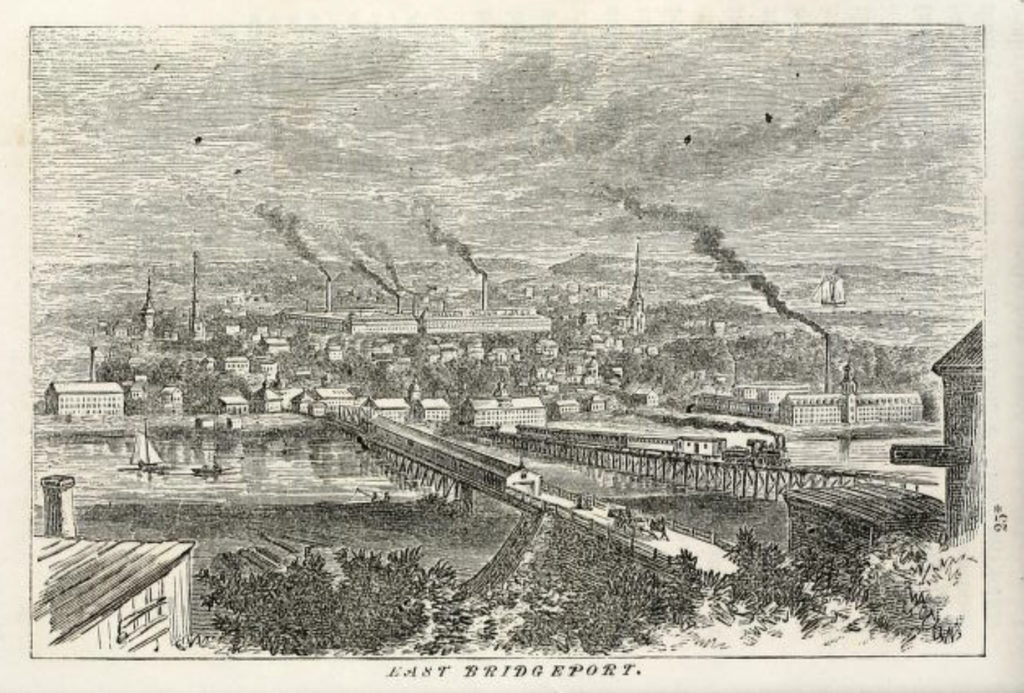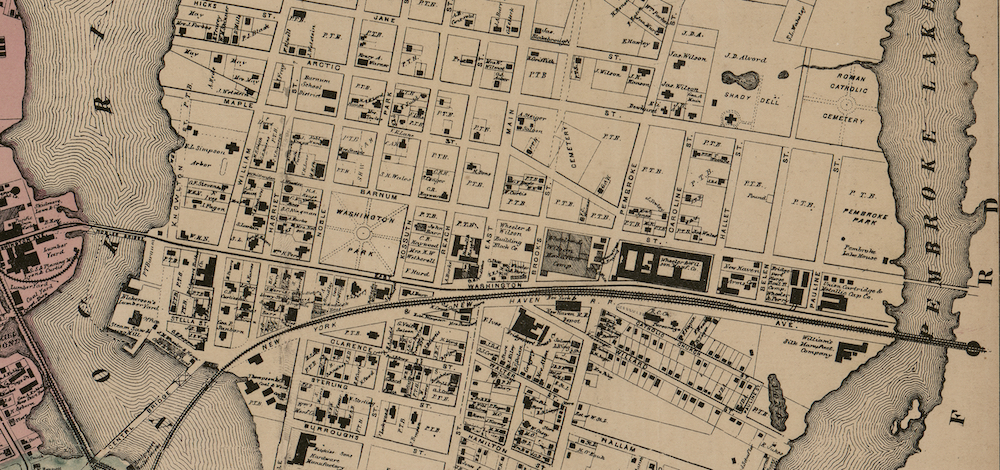
Frontispiece page, “Struggles and Triumphs:
Or Forty Years’ Recollections of P. T. Barnum” (1872 edition).
By Bruce E. Hawley
(c) Connecticut Explored Inc. Winter 2021-2022
Subscribe/Buy the Issue!
P. T. Barnum, the legendary showman, museum operator, and entrepreneur, was 41 years old in 1851. He had accumulated substantial wealth from promoting performers Tom Thumb and Jenny Lind. As Barnum says in his autobiography, to ward off the “temptation to rust in the repose which affluence induces,” he turned his attention to developing a new city on about 225 acres of land on the east side of the Pequonnock River in East Bridgeport, which, according to Elsie Danenberg in The Story of Bridgeport: 1836 – 1936 (Bridgeport Centennial, 1936), had seceded from the City of Bridgeport in 1839.
Barnum described his ambitious development plans in exacting detail in his autobiography Struggles and Triumphs: Or Forty Years’ Recollections of P. T. Barnum (1888 edition), quoted here from Waldo R. Browne’s 1927 Barnum’s Own Story: The Autobiography of P. T. Barnum – Combined & condensed from the various editions published during his lifetime (Dover, 2017).
In 1851, I purchased from Mr. William H. Noble, of Bridgeport, the undivided half of his late father’s homestead, consisting of fifty acres of land, lying on the east side of the river, opposite the City of Bridgeport. We intended this as the nucleus of a new city, which we concluded could soon be built up, in consequence of many natural advantages that it possesses.
Before giving publicity to our plans, however, we purchased one hundred and seventy-four acres contiguous to that which we already owned, and laid out the entire property in regular streets, and lined them with trees, reserving a beautiful grove of six or eight acres, which we inclosed (sic), and converted into a public park. We then commenced selling alternate lots, at the same price which the land cost us by the acre. Our sales were always made on the condition that a suitable dwelling-house, store, or manufactory should be erected upon the land, within one year from the date of purchase; that every building should be placed at a certain distance from the street, in a style of architecture approved by us; that the grounds should be enclosed with acceptable fences, and kept clean and neat, with other conditions which would render the locality a desirable one for respectable residents, and operate for the mutual benefit of all persons who should become settlers in the new city.
This entire property consists of a beautiful plateau of ground, lying within less than half a mile of the centre (sic) of Bridgeport city. A new footbridge was built, connecting this place with the City of Bridgeport, and a public toll-bridge which belonged to us was thrown open to the public free. We also obtained from the State Legislature a charter for erecting a toll-bridge between the two bridges already existing, and under that charter we put up a fine covered draw-bridge at a cost of $16,000 which also we made free to the public for several years. We built and leased to a union company of young coach makers a large and elegant coach manufactory, which was one of the first buildings erected there, and which went into operation on the first of January, 1852, and was the beginning of the extensive manufactories which were subsequently built in East Bridgeport.
Besides the inducement which we held out to purchasers to obtain their lots at a merely nominal price, we advanced one half, two-thirds, and frequently all the funds necessary to erect their buildings, permitting them to repay us in sums as small as five dollars, at their own convenience. This arrangement enabled many persons to secure and ultimately pay for homes which they could not otherwise have obtained. We looked for our profits solely to the rise in the value of the reserved lots, which we were confident must ensue. Of course, these extraordinary inducements led many persons to build in the new city, and it began to develop and increase with a rapidity rarely witnessed in this section of the country. Indeed, our speculation, which might be termed a profitable philanthropy, soon promised to be so remunerative that I offered Mr. Noble for his interest in the estate $60,000 more than the prime cost, which offer he declined.
“East Bridgeport,” from Struggles and Triumphs: Or Forty Years’ Recollections of P. T. Barnum (1872 edition)
It will thus be seen that, in 1851, my pet scheme was to build up a city in East Bridgeport. I had made a large fortune and was anxious to be released from the harassing cares of active business. But I could not be idle, and if I could be instrumental in giving value to land comparatively worthless, if I could by the judicious investment of a portion of my capital open the way for new industries and new homes, I should be of service to my fellow men and find grateful employment for my energies and time. I saw that in case of success there was profit in my project, and I was enough like mankind in general to look upon the enlargement of my means as a consummation devoutly and legitimately to be wished.
Yet, I can truly say that mere money-making was a secondary consideration in my scheme. I wanted to build a city on the beautiful plateau across the river; in the expressive phrase of the day, I “had East Bridgeport on the brain.” Whoever approached me with a project which looked to the advancement of my new city, touched my weak side and found me an eager listener. The serpent that beguiled me was any plausible proposition that promised prosperity to East Bridgeport, and it was in this way that the coming city connected me with that source of so many annoyances and woes, the Jerome Clock Company.
There was a small clock manufactory in the town of Litchfield, Connecticut, in which I became a stockholder to the amount of six or seven thousand dollars, and my duties as a director in the company called me occasionally to Litchfield and made me somewhat acquainted with the clock business. Thinking of plans to forward my pet East Bridgeport enterprise, it occurred to me that if the Litchfield clock concern could be transferred to my prospective new city, it would necessarily bring many families, thus increasing the growth of the place and the value of the property. Negotiations were at once commenced and the desired transfer of the business was the result. A new stock company was formed under the name of the “Terry & Barnum Manufacturing Company,” and in 1852 a factory was built in East Bridgeport.
In 1855, with hopes of attracting even more families to his beloved East Bridgeport, Barnum purchased a New Haven clock company known as the Jerome Clock Company that employed between 700 and 1,000 people and merged it with his Terry & Barnum Manufacturing Company. Unfortunately, that business transaction turned out to be a huge financial disaster for Barnum.
Upon reflection in his autobiography, Barnum said:
“[w]hen the blow fell upon me, I thought that I could never recover; the event has shown, however, that I have gained both in character and fortune, and what threatened, for years, to be my ruin, has proved one of the most fortunate happenings of my career. The ‘Bull Run’ of my life’s battle was a crushing defeat, which, unknown to me at the time, only presaged the victories which were to follow.”
Notwithstanding the Jerome Clock Company failure, around 1867 Barnum still owned the lots labeled “P.T.B.” on the above map of East Bridgeport. Also note that the streets bear the names of William Noble, who once owned part of the land, and of Barnum and his family members. Barnum and Noble avenues are major thoroughfares. Hallett Street was named after Barnum’s first wife Charity Hallett Barnum, and Caroline, Helen, and Pauline streets were named after their daughters. Barnum also hired a firm to design a park that resembled an English village green that was surrounded by churches and new housing.
Barnum’s dream to “open the way for new industries” on that “beautiful plateau of ground” came true with the construction of the massive sewing machine and gun manufacturing companies that operated in that area for generations. While those “manufactories” are long gone and East Bridgeport reunited with the City of Bridgeport in 1864, the “beautiful grove of six or eight acres” that Barnum reserved for Washington Park over 170 years ago are still there today for Bridgeport’s diverse community to enjoy.
Bruce E. Hawley is a board member of the Barnum Museum Foundation, the Circus Historical Society, and the Circus Fans Association of America. He is a distant cousin of P. T. Barnum.
Explore!
“Tom Thumb and the Age of Celebrity,” Spring 2015
Grating the Nutmeg Episode 60: Special CPTV Audio Documentary: The P. T. Barnum You Never Knew
Grating the Nutmeg Episode 30: P. T. Barnum and The Art of Money Getting
Ctexplored.org/listen or gratingthenutmeg.libsyn.com
GO TO NEXT STORY
GO BACK TO WINTER 2021-2022 CONTENTS


